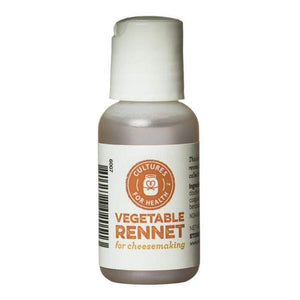
This is a basic, all-purpose cheese that can be used in a variety of ways: on crackers, for sandwiches, with fruit for dessert, or just as-is for a quick snack.
20 minutes
120 minutes
5
INGREDIENTS AND EQUIPMENT AVAILABLE AT CULTURES FOR HEALTH
Fresh Cheese Making Kit

Fresh Cheese Making Kit
$45.99
Our most comprehensive choice, the Fresh Cheese Kit contains two starter cultures and supplies to make five different varieties of soft cheese - feta, cottage cheese, cream cheese, fromage blanc, and traditional quark. Kit contains a Mesophilic Cheese Culture, a Fresh Cheese Culture, calcium chloride, vegetable rennet, cheese salt, butter muslin, a thermometer, and an instruction and recipe booklet.
Packaging and Equipment in the kit may appear different than pictured.
Mesophilic Direct-Set Starter Culture

Mesophilic Direct-Set Starter Culture
$14.99
From cheddar, Colby, and Monterey Jack to Feta, Chevre, and more, you'll enjoy the flavor and variety of homemade cheeses made using this starter culture.
Liquid Vegetable Rennet

Liquid Vegetable Rennet
$5.99
Double-strength liquid vegetable rennet. Each bottle contains enough rennet to set (24) 2-gallon batches of cheese.
Cheese Salt

INGREDIENTS:
- 2 gallons whole cow milk
- 1/2 tsp. direct-set mesophilic starter
- 1/2 tsp. liquid rennet diluted in 1/2 cup cool water
- Cheese salt
INSTRUCTIONS:
- Heat milk in a 10-quart non-reactive pot over low heat to 88°F, about 18-20 minutes.
- Turn off heat. Sprinkle the starter over the surface of the milk. Leave it to rehydrate for 5 minutes, then stir it in with a slotted spoon, using smooth, up-and-down motions until it is thoroughly incorporated. Cover and maintain the temperature at 88°F for 15 minutes to ripen.
- Add the diluted rennet slowly and stir in using the same up-and-down motion. Cover and let the milk sit undisturbed for 35-40 minutes, maintaining the temperature at 88°F.
- Once there is a clean break between curds and whey, cut the curds into 1/2-inch cubes. Do not stir, but let the cut curds sit undisturbed for 5 minutes.
- Return the pot to low heat, and very slowly heat to 98°F, bringing the temperature up by only about 1°F every 3-4 minutes. Stir continuously during this heating period to prevent the curds from sticking together (matting), and to cause them to release more whey and shrink to the size of peanuts.
- Once 98°F has been reached, turn off the heat. Cover and maintain the temperature, allowing the curds to rest for about 20 minutes, or until they have sunk to the bottom of the pot.
- Line a colander with clean, damp cheesecloth or butter muslin. Carefully begin scooping the warm curds out of the pot and into the lined colander. Let them drain in the colander for about 5 minutes, then move them, using the cloth around them as a sack, into an 8-inch tomme mold, keeping the cloth between the curds and the mold. Pull the cloth around the edges, eliminating any big wrinkles, and smooth it out as much as possible. Fold the tails of the cloth over the top of the curds, patting it slightly to get rid of any mussed spots.
- Set the follower on top of the covered curds, and press at 5 pounds of pressure for 15 minutes. Remove the cheese from the mold, unwrap it, flip it over, rewrap it and carefully place it back into the mold. Press the cheese again at 10 pounds for 12 hours.
- Prepare about a gallon of medium-strong brine (28 ounces of salt to 1 gallon of water), and chill it to 50°F. Take the cheese out of the mold and place it into the chilled brine. Put the cheese and brine together into the refrigerator and let the cheese soak in this manner for 2 hours.
- Take the cheese out of the brine and place it on a rack to air-dry in a cool, dark place away from drafts until the surface of the cheese is dry to the touch, or for about 24 hours. If any mold begins to develop on the surface of the cheese, simply rub it off with a small piece of cheese cloth wet in brine or a vinegar-water solution.
-
Wax the cheese and age it at 55°F for up to 4 months. Flip the cheese about once a week to ensure even ripening.
















